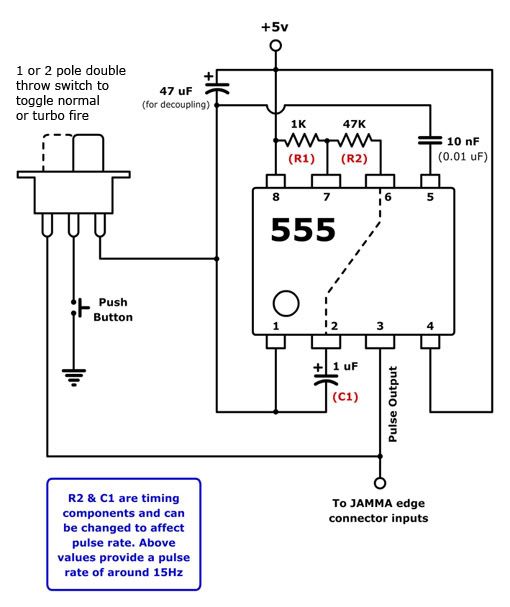SephirothFF
Quiz Detective

- Joined
- Jul 18, 2004
- Posts
- 80
After having searched the forums for information on this topic I have only found fragments from these two threads:
http://www.neo-geo.com/forums/showthread.php?t=20498
http://www.neo-geo.com/forums/showthread.php?t=113212
I also tried to use information from this site:
http://www2.asw.cz/~kubecj/atjoy.htm
but unfortunately I can't seem to work it out. I have bought an ne555 timer IC, 1 0.42nF capacitor, 1 100nF capacitor, 2 10K resistors and a 2-position switch (to turn autofire on/off). In the schematic that was drawn in the 113212 neo thread the IC pictured there is exactly the same as the one that I have but the ingredients needed to make the circuit seem to be different to those listed on the site directly above this paragraph. I am also not entirely sure about where to get +5 volts from on my supergun as it has that crappy arcade heaven wiring and how to implement the switch feature.
If anyone could possibly take the time to explain the wiring of this simple circuit for me then I would be eternally grateful.
http://www.neo-geo.com/forums/showthread.php?t=20498
http://www.neo-geo.com/forums/showthread.php?t=113212
I also tried to use information from this site:
http://www2.asw.cz/~kubecj/atjoy.htm
but unfortunately I can't seem to work it out. I have bought an ne555 timer IC, 1 0.42nF capacitor, 1 100nF capacitor, 2 10K resistors and a 2-position switch (to turn autofire on/off). In the schematic that was drawn in the 113212 neo thread the IC pictured there is exactly the same as the one that I have but the ingredients needed to make the circuit seem to be different to those listed on the site directly above this paragraph. I am also not entirely sure about where to get +5 volts from on my supergun as it has that crappy arcade heaven wiring and how to implement the switch feature.
If anyone could possibly take the time to explain the wiring of this simple circuit for me then I would be eternally grateful.






